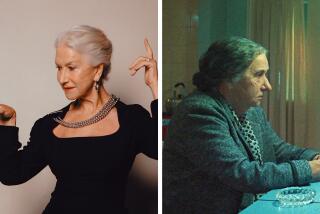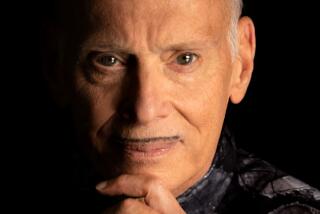The man inside the myth
John Wayne was larger than life. An unabashed conservative. Two-fisted. Macho.
He was also a superb craftsman who worked with some of the landmark directors of the 20th century, including John Ford, Howard Hawks, William Wellman and Don Siegel. Though he died in 1979 at age 72, his legacy looms large.
So large that USC’s School of Cinematic Arts, collaborating with Visions and Voices: The USC Arts & Humanities Initiative, is offering a three-day scholarly examination of the Duke titled “John Wayne: Actor, Star, Icon, Trojan.”
“When you have a conversation with people about John Wayne, the feeling is, ‘Ah, well, he wasn’t that much of an actor,’ ” says USC film professor Rick Jewell. “But if you have really seen most of his work, you know that is far from the case. He was an extraordinary actor.”
“The icon has overtaken the actor in many people’s eyes, I think,” says film historian Leonard Maltin. “So it’s high time the actor was reevaluated. There is nothing stupider than saying he was playing himself because I don’t know what the real himself was like, but from what I gathered it wasn’t that guy we saw on screen.”
The retrospective, which kicks off tonight and continues through Sunday at USC’s Norris Cinema Theatre/Frank Sinatra Hall, celebrates the famed USC alum through a series of classic films and discussions. The event also heralds the opening Sunday of a three-month exhibit of Wayne’s life and career in the David L. Wolper Center, in the lower level of USC’s Doheny Memorial Library, which features artifacts and memorabilia culled from Batjac Productions -- Wayne’s production company -- the USC Film Archives and private collectors.
This evening’s program features two of Wayne’s landmark westerns: 1939’s “Stagecoach,” the John Ford classic that made Wayne a star, and 1948’s sagebrush saga “Red River,” directed by Howard Hawks.
“He had a marvelous range,” Jewell maintains. “In certain roles, like in ‘The Searchers’ and “Red River,’ he is just absolutely powerful. He commands the screen, and you can’t imagine anybody else playing those roles. They are just the most captivating and powerful jobs of acting in screen history.”
Jewell admits that Wayne’s commanding presence does come through in roles so strongly that “you kind of fall back on that position that he never stretched. But he did stretch himself. He did play characters who weren’t just the white-hat heroes he started out playing in the movies. He played characters who had depth to them and psychological angst inside of them and who were not that admirable in so many ways.”
Wayne was careful about protecting his image, Maltin says. “He was a very canny fellow. He wasn’t a talk show regular, so we rarely got to see the real John Wayne. He did develop a kind of persona, a screen persona that he returned to more than once, but that was a creation -- and a damn good one too.”
Maltin will be moderating a panel discussion Sunday with Wayne’s daughter-in-law, Gretchen Wayne, who now heads up Batjac; Mark Rydell, who directed Wayne in 1972’s “The Cowboys,” and others.
The 1953 3-D western “Hondo,” in which Wayne plays a dispatch rider for the cavalry who meets a woman (Geraldine Page) living alone with her young son in the middle of hostile Apache territory, screens Sunday evening. Maltin believes it’s one of Wayne’s finest performances.
“There’s one long scene early on when he is talking to her while hammering some horseshoes. He has to hammer them, he has to fire them with the bellows, cool them in the water and hang them to dry on a rack. He has important dialogue through the entire scene where he is establishing his relationship with her while he performs all of these tasks. It’s like choreography. And he pulls it off flawlessly and seemingly effortlessly -- Olivier couldn’t have done it better.”
Gretchen Wayne is thrilled at USC’s tribute to her father-in-law because it “defines him as more than a movie star. There was more to him, and certainly he loved being a student at USC. He loved education.”
The Duke possessed a “terrific sense of humor,” says Wayne. “He didn’t like vulgarity. He certainly didn’t like it around women.”
And he was well loved in Hollywood. She recalls going to the first screening of 1969’s “True Grit,” for which Wayne won his only Oscar, with the Duke and her husband, Michael, who ran Batjac for 41 years.
“The audience went nuts when he did the scene where he puts the reins in his teeth and takes both guns. Lee Marvin jumped up in the middle of the audience and yelled, ‘Go get ‘em, Duke!’ The whole audience burst into laughter. It was such a spontaneous moment.”
The accompanying exhibition, says curator Sandra Garcia-Myers, has more than 200 posters and lobby cards, believed to be the largest Wayne poster collection ever displayed. “We have the hat from ‘Hondo,’ shirts he wore in different movies like ‘Rio Bravo’ and ‘The Searchers,’ ” she adds.
“We also have his director’s chair that he took to different film sets. It’s something that traveled with him. We have the hat from ‘The Green Berets’ and the eye patch from ‘True Grit.’ We are trying to show sort of a parallel vision of John Wayne -- who he was as an icon and who he was behind the scenes.”
Jewell, who will introduce each screening, chose all the films in the festival, including 1949’s “Sands of Iwo Jima,” for which Wayne received his first best actor nomination; 1972’s “The Cowboys”; his last film, 1976’s “The Shootist”; and two of the early B-movie serials that were Wayne’s bread and butter in the 1930s until he hit it big with “Stagecoach.”
“I wanted to show him at his best,” Jewell says.
--
--
‘John Wayne: Actor, Star, Icon, Trojan’
Where: Norris Cinema Theatre/Frank Sinatra Hall, USC
When: Today through Sunday at various times
Price: Free
Info: www-cntv.usc.edu
‘Duke: The Life and Legend of John Wayne’
Where: David L. Wolper Center at the Doheny Memorial Library, USC
When: 11 a.m.-5 p.m. Mondays through Fridays, through Feb. 6
Price: Free
Info: www-cntv.usc.edu
More to Read
The biggest entertainment stories
Get our big stories about Hollywood, film, television, music, arts, culture and more right in your inbox as soon as they publish.
You may occasionally receive promotional content from the Los Angeles Times.











